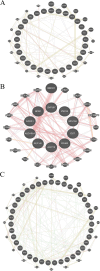Genome-wide association studies and candidate genes networks affecting reproductive traits using Iranian Holstein sequence data
- PMID: 40646471
- PMCID: PMC12247366
- DOI: 10.1186/s12864-025-11744-1
Genome-wide association studies and candidate genes networks affecting reproductive traits using Iranian Holstein sequence data
Abstract
Background: The reproduction process in domestic animals is one of the most important challenges of animal husbandry. Fertility is an important trait that contributes to herd profitability and can be improved by genomic information. One of the best ways to investigate the association between single nucleotide polymorphisms (SNPs) and phenotypic performance is the genome-wide association study (GWAS). The aim of our study was to identify the genomic regions affecting reproductive traits, interval between first and last insemination (IFL), days open (DO), days from calving to first service (DFS), number of services per conception (NSPC), age at first calving (AFC) and age at first insemination (AFI) using SNP chip data in Iranian Holstein cows.
Results: GWAS analysis for all reproductive traits based on the significant-association threshold P < 1 × 10-8, led to the identification of 55 single nucleotide polymorphisms (SNPs) for IFL (n = 3), DFS (n = 0), DO (n = 5), NSPC (n = 5), AFI (n = 33), and AFC (n = 9) traits. Based on the results of gene ontology analysis, 54 different candidate genes for reproductive traits were identified in this study. For IFL, NSPCC, DO, AFC, and AFI traits 4, 8, 11, 10, and 21 candidate genes were identified in the vicinity of significant SNPs, respectively. Key genes with biologically important positions for heifers (ATG7, PTPN5, STAC, GAD2, PLXDC2, KARS1, PRIM2, and ZNF597) and cows (LPL, SERP2, BIRC6, CENPU, PIK3C3, and MYLK3) can be mentioned.
Conclusions: Our results identified 55 marker-trait associations (MTAs) and 54 different candidate genes associated with reproductive traits. As a result, the SNPs and candidate genes discovered in this study can be used in genomic experiments to improve the reproductive performance of Iranian Holstein dairy cows and provide new information about the genetic architecture of these traits.
Keywords: Candidate genes; Iranian Holstein cattle; Reproductive traits; Whole-genome sequence.
© 2025. The Author(s).
Conflict of interest statement
Declarations. Ethics approval and consent to participate: The samples collected from the studied animals were performed in accordance with animal ethics and approved by the Animal Use Committee of the University of Tehran and the National Animal Breeding Centre of Iran. In addition, permission for sampling was obtained from the farmers on site. Also, we have obtained the informed consent of the owner(s) to use the animals in our study in this area from the University of Tehran and the National Animal Breeding Center of Iran. Consent for publication: Not applicable. Competing interests: The authors declare no competing interests.
Figures




References
-
- Henchion M, Moloney AP, Hyland J, Zimmermann J, McCarthy S. Trends for meat, milk and egg consumption for the next decades and the role played by livestock systems in the global production of proteins. Animal. 2021;15: 100287. - PubMed
-
- Heinke J, Rolinski S, Müller C. Modeling the role of livestock grazing in C and N cycling in grasslands with LPJmL5. 0-grazing. Geoscientific Model Development Discussions. 2022;2022:1–31.
-
- Mohammadi A, Alijani S, Rafat SA, Abdollahi-Arpanahi R. Single-step genome-wide association study and candidate genes networks affecting reproductive traits in Iranian Holstein cattle. Livest Sci. 2022;262:104971.
-
- Inchaisri C, Jorritsma R, Vos PL, Van der Weijden GC, Hogeveen H. Economic consequences of reproductive performance in dairy cattle. Theriogenology. 2010;74(5):835–46. - PubMed
-
- Ahlman T, Berglund B, Rydhmer L, Strandberg E. Culling reasons in organic and conventional dairy herds and genotype by environment interaction for longevity. J Dairy Sci. 2011;94(3):1568–75. - PubMed
MeSH terms
LinkOut - more resources
Full Text Sources
Research Materials
Miscellaneous

